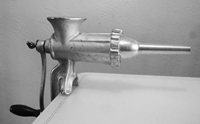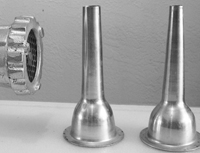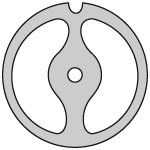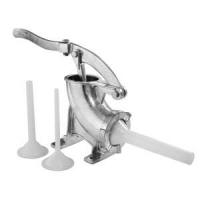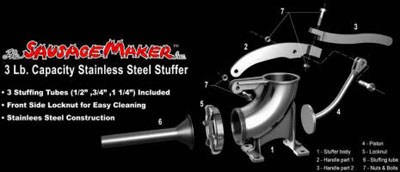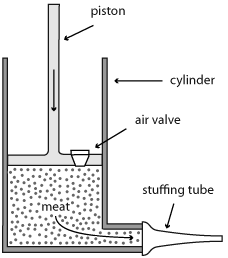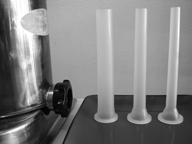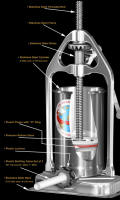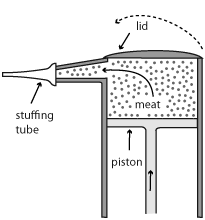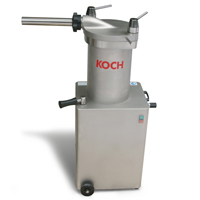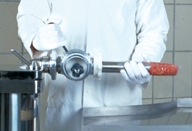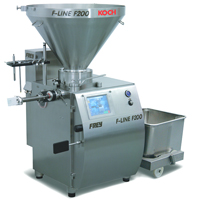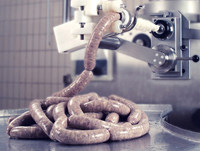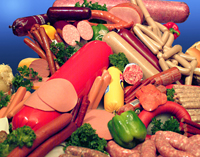Meats and Sausages
Stuffing
Stuffing sausages is labor intensive and the type of a stuffer used can make sausage making a pleasure or a difficult to perform chore.There is a distinct difference between stuffing requirements of a commercial meat plant, little butcher shop and a home sausage maker. Meat plants need a machine that will stuff, link and portion sausages in one cycle. Sausages must be of the same length and weight otherwise it would be impossible to estimate costs and run the business. Such machines are very expensive and can stuff thousands of pounds of sausage in one hour. The piston is powered by hydraulic pressure and the machine is controlled with a foot or a knee.
Butcher shops do not care much about linking and portioning sausages as the experienced sausage maker can fast link sausages by hand. Drawing on his experience he can estimate the weight of one foot of a particular diameter sausage. In addition the salesperson will weigh each order on a scale. What is important is that the stuffer performs faultlessly and is easy to operate and maintain. Such stuffers can be manually operated or can be hooked up to a motor.
Home sausage makers are concerned with the cost of the equipment and end up stuffing sausages with a grinder and the attached stuffing tube. This is a labor consuming operation that requires two persons. Recently, many manually operated piston stuffers (5-20 lbs. capacity) have entered the marketplace. They are inexpensive, reliable and some of them can be motorized.
Grinder Stuffer
The first known stuffer we know of was a simple funnel where casings were inserted on one end and the meat was pushed with fingers inside its opening. There still exists Polish sausage named “palcówka” ("palce" means fingers) that was done that way. The most popular method employed by home sausage makers is using hand cranked grinders with sausage tube attachements. It’s like in the example above with a difference that the meat grinder and not the fingers is pushing meat into the funnel. This arrangement has served us well for centuries, but it is a labor consuming operation normally requiring two persons.
The knife and plate are removed from the grinder and the auger pushes meat into the stuffing tube. It wobles quite a bit as it is not held in place by the plate which was removed. The optional spacer will provide support for the auger and the wobling will stop. The main drawback of this arrangement is that it requires two persons to stuff the casing. One has to insert meat into the mouth of the grinder and rotate the crank carefully not to loose the fingers. The second operator holds the tube and casing with his hand that works like a brake controling speed and and amount of meat that can be stuffed into the casing.
Horn Stuffer
There is a small (3-5 lbs.) horn stuffer and although the device looks cute and original nevertheless from the practical point of view is not much better than the hand grinder with tubes. It still requires two people to do the stuffing, though a strong person might be lucky to do it by himself. It is our opinion than a serious hobbyist should invest in a vertical piston stuffer which will make stuffing faster and more enjoyable. The money that is saved by not buying an electrically operated grinder can be reinvested into a purchase of a piston stuffer. By all means if you can afford it, buy all top of the line industrial automated equipment, but keep in mind that a manual grinder is an incredibly efficient device that can be successfully deployed in any production that requires 20 pounds or less of sausage.
Photos courtesy The Sausagemaker, Buffalo, NY
Manual Piston Stuffer
Piston is manually raised up and the cylinder is detached from the base for loading. There isn’t any lid on top of the cylinder. The cylinder is inserted back into the base and the piston is lowered down. By cranking the handle the gear forces the piston down the cylinder pushing meat in through the stuffing tube. Any air that might be compressed by the piston and delivered into the sausage escapes through the air valve.
There is a little built-in air valve into the piston to allow a release of air pressure that normally will be pushed inside of the sausage creating air pockets, On the bottom side of the cylinder we have an opening that accepts different sizes of sausage tubes. One person can easily control the casing and sausage speed with one hand and turn the handle that moves the piston down with the other.
Photos Courtesy The Sausage maker, Buffalo, NY
Hydraulic Piston Stuffer
Photos courtesy Koch Equipment, Kansas City, MO.

